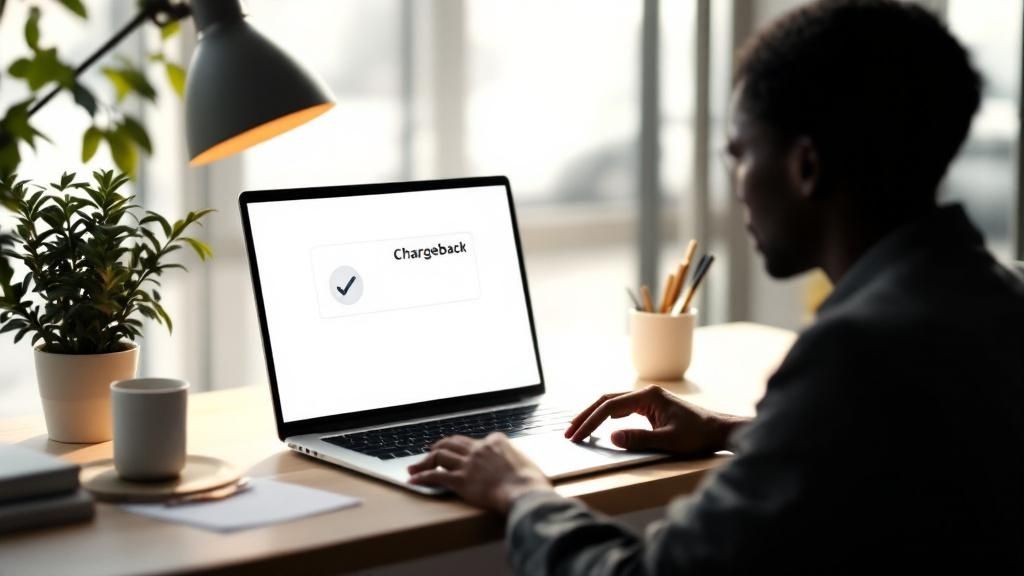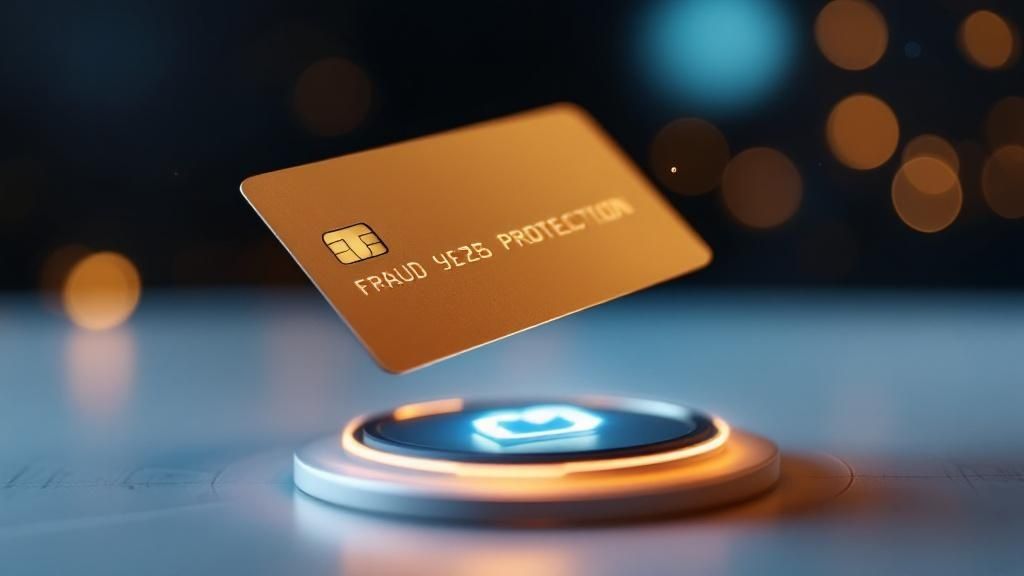
To win a chargeback fight, you first have to understand the opponent. This means getting to know the different types of disputes you'll face—from clear-cut fraud to simple customer mix-ups—and figuring out what kind of evidence you need to shut them down.
Why Chargebacks Happen and How to Prepare

Before you can build a solid defense, you need to know exactly what you're up against. A chargeback isn't just a simple refund. It's a formal, bank-led process kicked off by a customer. This process brings in a few key players: the cardholder, their bank (the issuing bank), your bank (the acquiring bank), and the card network like Visa or Mastercard.
Knowing who does what is key. When a customer disputes a charge, their bank immediately launches an investigation. They often hand the customer a provisional credit while pulling the same amount straight from your account. Your job is to fire back with enough compelling evidence to prove the transaction was legitimate.
This isn't a small problem, either. The global chargeback headache is getting worse, with projections showing a jump from $33.79 billion in 2025 to a staggering $41.69 billion by 2028. That's a 23% spike in just three years. The United States is ground zero, with the average chargeback costing merchants $110.
Decoding the Reasons for Disputes
Every single chargeback is tagged with a "reason code" from the card network. Think of these codes as your roadmap—they tell you exactly why the customer is disputing the charge. Learning to read them is your first step toward gathering the right evidence to win.
Most chargebacks fall into a few main buckets:
- True Fraud: This is the classic scenario—a stolen credit card is used for an unauthorized purchase. It's clear, it's criminal, and it's what most people think of when they hear "fraud."
- Merchant Error: Simple, preventable mistakes can be incredibly costly. We're talking about things like shipping delays, accidental double billing, or having a refund policy that's buried or confusing.
- Friendly Fraud: This is the tricky one. It happens when a customer disputes a legitimate purchase they actually made. Sometimes it’s an honest mistake, like forgetting about a subscription renewal. Other times, it's intentional—a way to get a product or service for free. For a deeper dive, check out our guide on the different types of https://www.chargepay.ai/blog/chargeback-fraud.
Common Scenarios and Their Triggers
Let's make this practical. A simple shipping delay can easily trigger a "Merchandise Not Received" chargeback. It makes sense from the customer's perspective.
Or consider your billing descriptor—the text that shows up on a customer's credit card statement. If it's something cryptic like "SP*WEBSERVICES" instead of your actual store name, don't be surprised when you get a "Transaction Not Recognized" dispute. They simply didn't know who you were.
Understanding the 'why' behind each chargeback is your greatest advantage. It allows you to move from a reactive defensive position to a proactive one, where you can anticipate and counter disputes with precision.
Once you get these fundamentals down, you can start preparing the exact documentation needed for each scenario. This basic knowledge shifts your entire strategy from just reacting to disputes to strategically dismantling them with proof.
Building Your First Line of Defense

The single best way to fight a chargeback is to make sure it never happens in the first place. This is where your proactive defense comes in—simple, powerful practices that stop disputes before they can even start. It’s all about building a strong foundation that secures your transactions and cuts off risk from the get-go.
Think about it from your customer’s perspective. They’re scrolling through their bank statement and see a charge from "XYZ*SERVICESLLC." They don't recognize it, panic, and immediately call their bank. A few weeks later, you have a chargeback on your hands.
This all-too-common scenario is easily preventable with a clear billing descriptor. Instead of some generic code, make sure the text that appears on their statement clearly identifies your store name. It’s a tiny detail that can save you a massive headache.
Beef Up Your Checkout Security
Beyond simple clarity, your checkout process itself is a critical spot to defend. For any online merchant today, implementing basic fraud detection tools is a must. Think of these systems as your digital bouncers, checking IDs at the door to make sure only legitimate customers get through.
Two of the most essential tools are:
- AVS (Address Verification System): This tool checks if the billing address entered by the customer matches what their credit card company has on file. A mismatch is a huge red flag for potential fraud.
- CVV (Card Verification Value): This is that three or four-digit security code on the card. Requiring it proves the customer has the physical card in their possession, making life much harder for fraudsters who only have stolen card numbers.
Implementing AVS and CVV checks is a standard practice that issuing banks expect to see. When you're fighting a chargeback, being able to show that these checks were performed and passed adds a serious layer of credibility to your case. It shows you did your due diligence.
Communication Is Your Secret Weapon
A shocking number of chargebacks have nothing to do with actual fraud and everything to do with poor communication. When customers feel confused, ignored, or misled, their first move is often to dispute the charge rather than contact you for help.
This is especially common in cases of what's known as accidental friendly fraud, where a legitimate customer disputes a charge purely out of confusion or frustration.
The most effective way to prevent these disputes is to be transparent and incredibly easy to reach. A customer who knows they can get a quick answer from you is far less likely to call their bank.
I’ve seen this work firsthand. One merchant managed to slash their friendly fraud disputes by 30% with one simple change: they started sending proactive email and SMS updates about shipping and delivery timelines. This constant communication loop reassured customers that their order was on its way, completely eliminating the anxiety that often leads to "item not received" claims.
Here are a few other communication-based tactics that work wonders:
- Display a Clear Refund Policy: Don't bury it. Make your policy easy to find and even easier to understand. If a customer knows they can get a refund by talking to you, they will.
- Set Accurate Shipping Times: Be honest about how long delivery will take. It's always better to under-promise and over-deliver.
- Offer Responsive Customer Service: Make it dead simple for customers to contact you via email, phone, or live chat. A quick, helpful response can defuse a potential dispute in minutes.
How to Build a Winning Chargeback Case
That gut-punch feeling when a chargeback notification lands in your inbox is all too familiar. It’s easy to get frustrated, but don't just write it off as a loss. Think of it as a challenge you can absolutely win—if you have the right game plan. Building a winning case isn't about luck; it's about systematically gathering the kind of compelling evidence that leaves no room for doubt.
Your first move, always, is to dissect the reason code. This little piece of information tells you exactly why the customer is disputing the charge, which dictates the kind of proof you need to gather. Just firing back a generic invoice is like showing up to a sword fight with a butter knife. It’s simply not going to cut it.
A weak response is just that—an invoice and a hopeful click of the "submit" button. A strong, winning response, on the other hand, is a carefully assembled file that tells the clear, undeniable story of a legitimate transaction. This means collecting the right evidence, drafting a professional rebuttal, and submitting it all before the deadline.
This quick visual breaks down the core steps to build your chargeback response.

As you can see, it's a logical flow from evidence collection to submission. Follow it, and you're already presenting a much more structured and convincing case.
Tailoring Evidence to the Claim
The secret to winning is matching your proof to the customer's specific claim. The evidence you need depends entirely on the dispute reason.
For "Item Not Received" Claims: This one is pretty straightforward. Your primary weapon is proof of delivery. A tracking number is good, but delivery confirmation with a signature or a photo of the package on the customer's doorstep is even better. Solid, verifiable proof is your best friend here.
For Digital Products or Subscriptions: This can feel trickier since there's no physical item to track. Your best evidence often comes from user logs. Can you show that the customer logged in, downloaded the file, or actively used the service after the purchase date? IP address records that match the customer's location at the time of use are incredibly powerful.
For "Transaction Not Recognized" Claims: Here, your job is to connect the cardholder to the purchase. Evidence like AVS (Address Verification System) and CVV matches are crucial. You can also include customer emails confirming the order or even point to a history of previous, undisputed purchases from the same customer.
Evidence Checklist for Common Chargeback Reasons
To make things easier, here’s a quick-reference table. Use it as a checklist to ensure you’re grabbing the most impactful evidence for the most common dispute types.
This isn't an exhaustive list, but it covers the heavy hitters. The more relevant proof you can provide, the stronger your position becomes.
Crafting the Rebuttal Letter
Once you have your evidence locked and loaded, you need to write a professional rebuttal letter. This isn't the place for emotion or angry rants; it’s about presenting the facts clearly and concisely.
Think of it as the cover letter for your evidence package. It should briefly summarize the dispute and then walk the bank's analyst through each piece of proof you’ve provided, explaining exactly how it disproves the customer's claim. Keep it short, factual, and easy to scan. A well-organized letter makes the bank's job easier, which can only help your chances. For a deeper dive, you can explore the art of chargeback representment and how to structure your arguments for maximum impact.
A strong rebuttal doesn't just present evidence; it guides the reviewer to a logical conclusion. It connects the dots for them, making it simple to see why the chargeback should be reversed in your favor.
Let's look at two approaches. A merchant who just uploads an invoice for a "not received" claim has a very low chance of success. But a merchant who provides a signed delivery slip, a screenshot of the customer’s order confirmation email, and a clear rebuttal letter explaining the timeline has built an undeniable case.
By organizing your evidence and telling a clear story, you dramatically increase your odds of winning the dispute and getting your money back where it belongs.
Using Automation to Fight Disputes at Scale

Let's be honest, manually fighting every single chargeback is a soul-crushing task. For any growing business, it quickly turns into an unsustainable game of whack-a-mole, draining your time and resources. This is exactly where automation tools like ChargePay can completely flip the script on how you manage disputes.
Automation isn’t about replacing your team; it’s about giving them superpowers. Instead of your staff spending hours digging through different systems for a single piece of evidence, these tools can instantly pull everything they need. They plug directly into your CRM, shipping software, and payment processor to gather compelling evidence in seconds.
This is more important than ever, especially when you look at the numbers. Chargeback volumes are projected to surge by 24% by 2028, ballooning to an estimated 324 million disputes worldwide each year. Every single one of those comes with hidden costs for merchants, from bank fees to the staff hours wasted on manual responses. You can dig deeper into the true cost of chargebacks to see how those expenses really add up.
Slashing Response Times with Smart Tech
Think about a real-world scenario. A "product not received" dispute lands in your inbox. Manually, one of your employees has to log into Shopify to find the order, jump over to your shipping provider's site to grab the tracking details, and then stitch it all together into a rebuttal letter. That whole process can easily eat up 30 minutes to an hour for just one dispute.
With automation, that entire workflow is crushed down into a few moments.
The real magic of automation isn't just that it gathers data, but that it intelligently assembles it. It transforms a tedious, error-prone chore into a fast, consistent, and scalable process.
The system instantly identifies the dispute reason, fetches the corresponding delivery confirmation from FedEx, and attaches the customer's order details from your e-commerce platform. From there, it uses AI to analyze the reason code and generate a compelling, evidence-backed response that’s tailored to win that specific type of claim.
From Hours to Minutes
What once took an hour of focused effort now takes just a few minutes of review. This massive time savings frees up your team to stop chasing paperwork and start focusing on what actually grows your business.
Suddenly, you can:
- Fight More Disputes: When the process is this efficient, you can afford to fight every single illegitimate chargeback, not just the big ones.
- Recover More Revenue: Higher efficiency leads to a higher volume of well-crafted responses, which directly translates to a better win rate and more money back in your bank account.
- Scale Without Fear: As your business grows, your chargeback system can grow right alongside it, without you needing to hire a dedicated dispute team.
By automating the grunt work, you can finally fight chargebacks at scale and protect your bottom line without sacrificing your team's valuable time. It’s a strategic shift that lets you handle disputes with precision and focus your energy on bigger goals.
Turning Chargeback Data into Smarter Decisions
You won't win every single dispute. That’s just a fact of doing business, and that’s okay.
The real win comes from treating every chargeback—win or lose—as a valuable piece of intel. Each one tells a story about your products, your customers, or your internal processes. Adopting this mindset transforms a reactive chore into a powerful tool for making smarter decisions that actually move the needle.
Instead of getting bogged down fighting chargebacks one by one, start looking for the bigger picture. Are you suddenly seeing a spike in disputes from a specific country? It might be time to tighten your fraud filters for that region. Is one particular product getting hit with "not as described" claims over and over? That’s a crystal-clear signal to update your product page with better photos or a more detailed description.
Finding Actionable Patterns
Uncovering these patterns starts with tracking a few key metrics. You don’t need a complicated system to get going. Just start monitoring a handful of data points to find where you're most vulnerable.
Here are the essentials to watch:
- Chargeback Rate by Product: Instantly flags which items are causing the most headaches.
- Chargeback Rate by Reason Code: Shows you why customers are disputing charges (e.g., genuine fraud vs. service issues).
- Chargeback Rate by Country: Helps you pinpoint geographic hotspots for fraudulent activity.
Sometimes, a sudden jump in chargebacks is tied to wider industry trends. For example, the online travel sector saw an eye-watering 816% year-over-year increase in chargebacks in early 2024, while general eCommerce wasn't far behind with a 222% rise. These spikes were driven by things like widespread shipping delays and a surge in friendly fraud. Spotting these trends early helps you get ahead of the curve.
From Insight to Action
Once you've identified a pattern, the next step is to actually do something about it.
Let's say you discover that a high number of your disputes are coming from first-time buyers in a specific region. That’s your cue to implement stricter security checks for those transactions. Taking these kinds of proactive steps is a core part of any effective chargeback fraud prevention strategy.
Think of your chargeback data as a free consulting report. It points directly to the friction points in your business, giving you a clear roadmap for what to fix next.
This continuous feedback loop is what separates the businesses that constantly struggle with chargebacks from those that master them. By analyzing your data, you can make targeted improvements that not only help you win more disputes but also prevent them from happening in the first place. That’s how you protect your revenue and build a stronger, more resilient business for the long haul.
Got Questions About Fighting Chargebacks? We’ve Got Answers.
Even with a solid game plan, stepping into the world of payment disputes can feel like trying to navigate a maze blindfolded. The rules are confusing, the deadlines are tight, and it’s easy to feel overwhelmed.
Let's clear the air. Here are some straight-up answers to the most common questions we hear from merchants just like you.
How Long Do I Have to Respond to a Chargeback?
Time is not your friend here. Once a dispute lands, the clock starts ticking, and it ticks fast.
This response window, often called the rebuttal period, depends on the card network (like Visa or Mastercard). Typically, you're looking at a window of 20 to 45 days. Your payment processor will spell out the exact due date in the chargeback notification. Treat that date like it’s set in stone—because it is. Miss it, and you automatically lose. No second chances.
What Is Friendly Fraud and How Do I Fight It?
Ah, friendly fraud. It's probably the most maddening type of dispute you'll ever face. This happens when a legitimate customer disputes a charge they actually made. Maybe they forgot about the purchase, didn't recognize your business name on their statement, or are just feeling a bit of buyer's remorse.
Your only move is to hit back with undeniable proof. Your job is to prove beyond a shadow of a doubt that the real cardholder authorized the transaction and got exactly what they paid for.
Compelling evidence is your only weapon against friendly fraud. You need to build a case so strong that it leaves no doubt in the bank’s mind that the purchase was valid.
The kind of evidence that really moves the needle includes:
- Customer service emails or chat logs where they discuss the order.
- IP logs showing the purchase came from a familiar device or location.
- Delivery confirmations, especially with a signature or photo proof.
- Proof that the customer has used the product or service since the purchase.
Can I Stop a Customer From Filing a Chargeback?
You can't physically stop someone from calling their bank, but you can absolutely make them not want to. The best way to do that is through stellar customer service and proactive communication.
Think about it: a chargeback is usually a customer's last resort when they feel ignored or frustrated. If you give them a clear, easy way to solve their problem directly with you, most will take it. Make your refund policy simple to find, use a billing descriptor they’ll actually recognize, and keep them in the loop with order and shipping confirmations.
Is It Really Worth Fighting a Chargeback for a Small Amount?
Yes. A thousand times, yes. It is almost always worth fighting even the smallest chargebacks.
When you let disputes slide, you're sending a signal to banks that you might not have your operations buttoned up, which can attract more scrutiny later. It's a tough pill to swallow, but knowing how often merchants win chargeback disputes can help put your own strategy into perspective.
More importantly, every single chargeback—no matter the dollar amount—counts toward your chargeback-to-transaction ratio. If that ratio gets too high, your processor could slap a "high-risk" label on you. That can lead to higher fees, frozen funds, or even losing your merchant account entirely.
Ready to stop losing revenue to time-consuming disputes? ChargePay uses AI to automate the entire chargeback fighting process, from gathering evidence to submitting winning responses. Reclaim your lost revenue and get back to growing your business by visiting https://www.chargepay.ai.







.svg)







.svg)
.svg)
.svg)